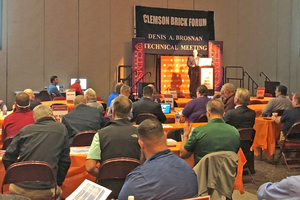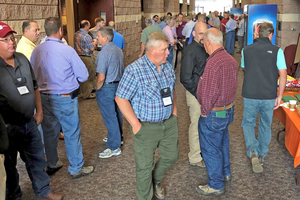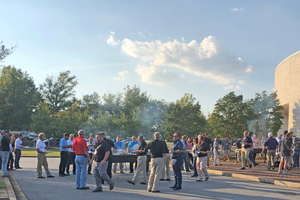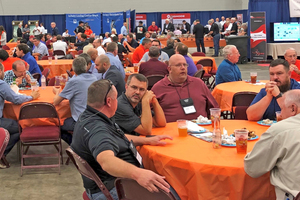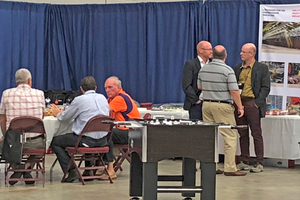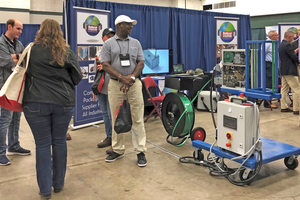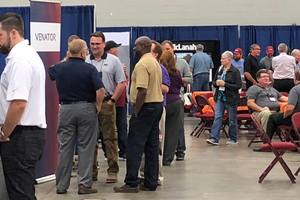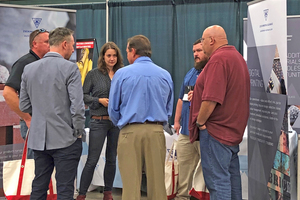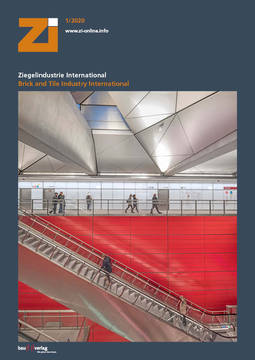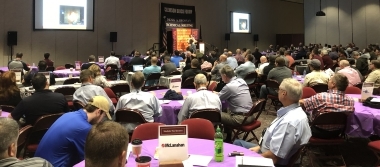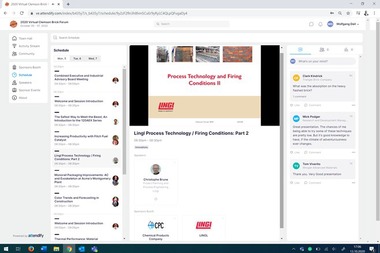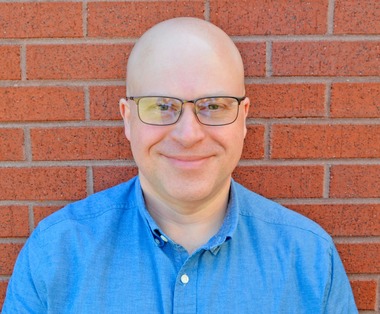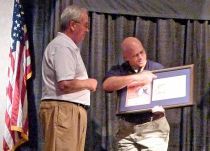The North American brick and tile industry met at 65th Clemson Brick Forum
Around 400 attendees met on 1 and 2 October for the anniversary event of the Clemson Brick Forum at “Anderson (SC) Sports and Entertainment Center”. There were some new additions to the programme. The focus of the programme was on production-related topics.
1 New at the Forum
John Sanders, Director of the National Brick Research Center and the Brick Forum, welcomed the attendees and informed them about some new aspects. This time, the event programme stretched over the entire Tuesday and Wednesday, finishing on Wednesday evening with the famous steak cookout. All attendees had the opportunity not only to benefit from the professional further training but to deepen contact with the exhibiting companies. Moreover, the exhibitors had the chance to introduce their product range to interested brickmakers in small groups as part of the training programme. These options were used by a total of eight exhibitors. The brickmakers had opportunities to ask questions and discuss problems in relatively small groups. These “Vendor Success Sessions” proved very popular.
John Sanders updated the attendees on “WikiBrick”, a technical source available online for all NBRC members. In a project with students at the Clemson University, work is already underway on an app version.
With “Attendify”, John Sanders presented the event app for the Forum. This free and easy-to-use app not only provided information, it was a lot of fun, too. The attendees could look forward to various prizes that they were able to win during this interaction. The aim on the one hand was to encourage the sharing especially of professional know-how among the attendees. But the “fun factor” wasn’t forgotten either. The best answer to a question asked got a prize as did the best selfie from the cookout.
2 Professional programme
The programme covered a wide range of topics from raw materials preparation through extrusion to drying and firing. The focuses also included innovative manufacturing technologies like the production of brick slips, 3D and digital printing. Other talks addressed, for instance, thermal properties, fire resistance and impact resistance of masonry wall systems.
Clement Cadier, Direxa, opened the technical programme on Tuesday with a paper on fundamental aspects, which went from clay characterization to the finished product. Cadier pointed out the differences in brick products worldwide. He explained the range of application of, for example, thermal insulation blocks in Europe and hollow blocks in Saudi Arabia, the use of ceiling blocks in South America, the laying of clay pavers in Europe and the USA to products for sound insulation and protection against the sun.
The first talks addressed mine exploration, raw materials and the ideal clay blend. Tommy Scalf, General Shale, for instance, spoke on raw material exploration and its effective communication. He compared results from Google Earth with those obtained with the Geographic Information System (GIS). With GIS, it is possible to record, save, process, analyse, manage and present geographic data. The two systems have their advantages, but it is necessary to check out which method is most suitable in the prevailing conditions (vertical, horizontal or pitching structures).
Ramesh Lakshmann, Meridian Brick, explained how quickly calcium carbonate can be detected in raw materials and gave an overview of various analysis methods, starting from low-cost methods to expensive X-ray fluorescence analysis.
In his paper on lean manufacturing, Mario Giffuni, Pinehall Brick, emphasized that this required a cultural change in the company. He informed the attendees about the various tools, e.g. 5 S. With reference to his own company story, he explained the implementation and benefit of lean manufacturing. With regard to the aspect of safety, he explained measures such as the creation of a safety dashboard, the reduction of noise levels, the optimization of lighting, the reduction of dust emissions, etc.
The digital twin and its importance in plant engineering in the clay brick and tile industry was the topic addressed by Markus Mart, Lingl. The object, he said, was to make complexity manageable. The basis of the solution developed by Lingl is the Lingl Visualization System MBVL, of which 800 have already been installed. The digital twin enables support, e.g. in maintenance, ordering of replacement parts and other things. The system offers the customer several advantages, e.g. the machine status is displayed in real time in the operating systems and contains additional information.
How to work with employees was the subject of the talk by Don Vestal, Meridian Brick. His simple tip is: Keep it simple – plain words, easy to understand tasks and objectives, only give whatever explanations are necessary – understandable for everyone. He recommended that managers give out daily a strategic list of standard goals. The focus should be on the process. Management is successful when every employee is acquainted with the strategy and everyone knows what part they have to play to reach the goals.
In his talk, Nate Huygen, National Brick Research Center, established that radiant barriers can influence the thermal performance of brick shells, without any need to increase the wall thickness as these can be inserted in the layer of air between the wall and facing.
In an emotional talk, Bryan Light, Brick Industry Association (BIA), enthused about the beauty of the brick and demonstrated that with reference to an imposing brick structure that showcases all the facets of the product.
Following a talk by Chip Clark, BIA, on the topic of EPDs, the first day of talks ended with Brian Trimble‘s, International Masonry Institute, statement on the question: Are bricklaying robots friends or foes? The use of robots in masonry construction can certainly contribute to making brick masonry more competitive. The brick industry should think about new product shapes and sizes. Here, however, the building professionals should always be involved and trained.
The second day of talks started with papers on 3D printing and digital printing. Dr. Fritz Mödinger, Smalticeram Unicer SpA, informed attendees in a general paper about the basics of digital printing. He defined the advantages, such as wider range of surface design possibilities – without changing anything about the body, lower costs, flexible production, reproducibility – even after many years, manufacture of small unit numbers. With this process, new customers can be won, and markets opened up. Adjustments in the production process may, however, become necessary with the introduction of digital printing.
Charles Savage, The Belden Brick Company, spoke on glazed bricks. The brick company has invested in Plant 8 to produce glazed bricks in a single firing and therefore at lower cost. Belden has experience in firing glazed bricks, which, however, had previously been twice-fired in a shuttle kiln. In Plant 8, dry bricks are glazed, dried in a chamber dryer, and 100 000 bricks/day are glazed and fired in the tunnel kiln, all shapes can be glazed. With a wide variety of colours based on selected base colours, customized solutions can be provided.
In a very field-oriented paper, Claudia Istel, Zschimmer & Schwarz Inc., reported on opportunities and challenges in digital printing in the clay brick and tile industry. She explained the use of truecolor inks, which can be bought ready to print. Even if up to 12 different inks can be used, with just four colours, a wide variety of products can be achieved. The number of printheads determines the costs for the printing system. With reference to a project implemented in a brickworks, Istel explained the parameters of digital printing. Printing speeds between 5 and 24 m/min can be realized, with a print resolution of 360 dpi. Both headers and stretchers can be printed. The printing system is mobile and can be moved to or from the line in just 10 to 20 mins.
Marc Bradburry, Triangle Brick, presented a project on 3D printing from the perspective of a brickmaker. In the brick plant, rollers for the surface design of bricks were printed in a 3D process. With this process, brickmakers can realize their own ideas, which guarantees exclusivity. They are independent of delivery times and can print at low cost. Bradburry was very keen: “It’s time to change the world!”.
The other talks addressed, for example, the technological steps of setting, drying and firing. The talks were rounded off with environmental aspects.
3 Sharing ideas
The Tuesday evening was used to share experience and first talks with the more than 40 suppliers, who presented their range of products and services in the accompanying exhibition.
The traditional steak cookout wasn’t on the programme until Wednesday evening. To conclude the forum, the opportunity was given for all attendees to get talking to each other. At several huge barbecue grills, everyone did their best and barbecued their favourite steak while engaging in interesting discussions. Then the suppliers in the exhibition hall informed the attendees about their range.
The next Clemson Brick Forum is taking place from 6 to 7 October 2020.

